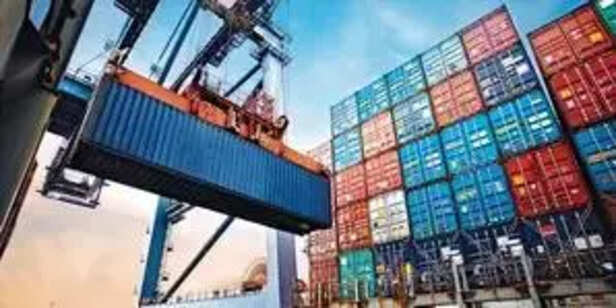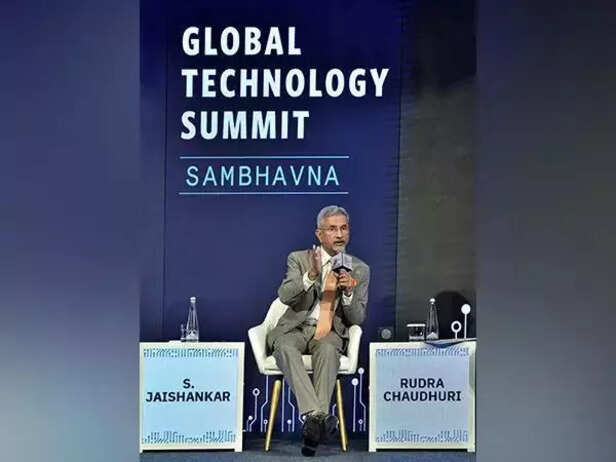US vs India Over Russian Oil: How Real Is the 500% Tariff Threat?
Nidhi | Jul 03, 2025, 13:21 IST
( Image credit : ANI, Timeslife )
When a new US bill threatens a massive 500% tariff on nations buying Russian oil, India — now Russia’s top crude customer — faces tough questions about its energy security and global partnerships. This article explains how India’s Russian oil imports surged from 50,000 to 1.96 million barrels per day, why discounted crude keeps fuel prices stable for 1.4 billion people, and how Jaishankar’s calm response signals India’s plan to protect its economy if sanctions become real.
What happens when the world’s biggest democracy becomes the biggest buyer of discounted Russian oil — just as Washington tries to choke off Moscow’s war funds? You get a threat that sounds straight out of a trade war: a 500% tariff on any country that keeps importing Russian oil.
This isn’t just a throwaway line. It’s a real bill in the US Senate — with over 80 co-sponsors and a big goal: make it too painful for countries like India to keep buying Russian crude. But how real is this threat? How dependent is India on Russia? And what does India’s measured response actually tell us about what might happen next?
Here’s where the numbers, the politics, and the strategy meet — and why India’s answer, for now, is simple: “We’ll cross that bridge when we come to it.”

1. From 50,000 to 1.96 Million Barrels a Day
Before Russia’s invasion of Ukraine in February 2022, India bought just 50,000 barrels per day of Russian crude — about 1% of its imports. By May 2025, that figure has skyrocketed to 1.96 million barrels per day, making Russia India’s largest oil supplier.
2. Why So Much Russian Oil?
Russia’s deep discounts — often $20–30 cheaper per barrel than Brent — are too good for India to ignore. For a nation importing over 85% of its oil and with stagnant domestic production, cheap Russian crude helps keep fuel prices low for 1.4 billion people and the government’s fiscal deficit under control.
3. No Legal Ban, Strategic Autonomy
Unlike Europe or the US, India never signed on to Western sanctions or price caps. By not binding itself legally, India retains the freedom to buy what it needs, when it needs it. This “strategic autonomy” has allowed India to navigate between cheap energy and its Western partnerships.

4. What the Bill Says
US Senator Lindsey Graham’s bill, introduced in June 2025, seeks a 500% tariff on imports from any country buying Russian oil, gas, uranium, or similar products. Backed by over 80 co-sponsors, the bill’s goal is to drain Russia’s energy revenue by punishing its biggest customers.
5. Can It Really Become Law?
While the bill has momentum, it must still pass both chambers of Congress and get the President’s signature. Foreign policy experts and industry groups have warned that the move could hurt US allies like India, disrupt supply chains, and even push New Delhi closer to Moscow or Beijing. For now, it remains a powerful threat — but not yet a reality.
6. Trade That Keeps Growing
US-India trade in goods and services hit $129.2 billion in 2024. Both countries hope to push this figure to $500 billion by 2030. A blanket tariff could hurt this goal and cause collateral damage far beyond oil.
7. Defense and Indo-Pacific Cooperation
India is one of America’s most crucial defense partners, a key player in the Quad alliance (US, India, Japan, Australia) designed to counter China’s assertiveness in the Indo-Pacific. Jaishankar’s recent US visit wasn’t just about oil; he also flagged the South China Sea as a major shared concern, underscoring that India and the US have overlapping security interests that neither side wants to jeopardize.
8. Energy Tech and LNG
The US wants to sell more liquefied natural gas (LNG) and advanced energy technology to India. Pushing India too hard on Russian oil could backfire by driving India toward other suppliers and complicating these growing energy ties.

When asked about this proposed tariff during his recent US visit, External Affairs Minister S. Jaishankar was characteristically clear:
“We’ll cross that bridge when we come to it. We have been in touch with Senator Lindsey Graham and other lawmakers. Our concerns — particularly energy and security — have been made clear.”
In other words, India isn’t ignoring the bill — but it also isn’t going to make panic policy changes for something that may never become law.
So, How Real Is the 500% Tariff Threat? Right now, the threat is more of a signal than a certainty. India knows this, and Jaishankar’s message — “We’ll cross that bridge when we come to it” — says it all. If the bill ever does pass, India will likely push for carve-outs, shift some of its oil mix, and negotiate its way through — just as it did with Iran’s oil when sanctions hit in 2019.
 Jaishankar’s visit also highlighted that energy is only part of the US-India conversation. He flagged the South China Sea as an issue of “great concern” for all Quad members (India, the US, Japan, Australia).
Jaishankar’s visit also highlighted that energy is only part of the US-India conversation. He flagged the South China Sea as an issue of “great concern” for all Quad members (India, the US, Japan, Australia).
With trillions in trade flowing through those waters, any instability or aggression — particularly by China — directly impacts India’s maritime and energy security. It’s a reminder that India and the US still share deep interests that go beyond Russian oil.
For now, the threat is more a sign of political pressure than an immediate reality. Yes, the bill has traction in the Senate. But the final hurdles — House passage, White House approval, and practical implementation — remain significant.
India’s position is clear: it will protect its energy security, manage costs for its people, and keep lines of diplomacy open. And if the bill ever does become law? India is already signaling that it will negotiate, adapt its oil mix, and find ways to limit economic fallout — just as it did when Iran faced sanctions years ago.
A 500% tariff threat makes for a dramatic headline, but turning it into real policy is a different game. In the meantime, India will keep buying smart, balancing its strategic partnerships, and making sure its 1.4 billion people don’t pay the price for someone else’s geopolitical crossfire.
This isn’t just a throwaway line. It’s a real bill in the US Senate — with over 80 co-sponsors and a big goal: make it too painful for countries like India to keep buying Russian crude. But how real is this threat? How dependent is India on Russia? And what does India’s measured response actually tell us about what might happen next?
Here’s where the numbers, the politics, and the strategy meet — and why India’s answer, for now, is simple: “We’ll cross that bridge when we come to it.”
The Numbers Behind India’s Russian Oil Pivot

US faces steeper crude oil production decline than previously anticipated_ S&P Global Commodity Insights.
( Image credit : ANI )
1. From 50,000 to 1.96 Million Barrels a Day
Before Russia’s invasion of Ukraine in February 2022, India bought just 50,000 barrels per day of Russian crude — about 1% of its imports. By May 2025, that figure has skyrocketed to 1.96 million barrels per day, making Russia India’s largest oil supplier.
2. Why So Much Russian Oil?
Russia’s deep discounts — often $20–30 cheaper per barrel than Brent — are too good for India to ignore. For a nation importing over 85% of its oil and with stagnant domestic production, cheap Russian crude helps keep fuel prices low for 1.4 billion people and the government’s fiscal deficit under control.
3. No Legal Ban, Strategic Autonomy
Unlike Europe or the US, India never signed on to Western sanctions or price caps. By not binding itself legally, India retains the freedom to buy what it needs, when it needs it. This “strategic autonomy” has allowed India to navigate between cheap energy and its Western partnerships.
Inside the US 500% Tariff Proposal

US tariffs give India a definitive edge over China in key sectors.
( Image credit : IANS )
4. What the Bill Says
US Senator Lindsey Graham’s bill, introduced in June 2025, seeks a 500% tariff on imports from any country buying Russian oil, gas, uranium, or similar products. Backed by over 80 co-sponsors, the bill’s goal is to drain Russia’s energy revenue by punishing its biggest customers.
5. Can It Really Become Law?
While the bill has momentum, it must still pass both chambers of Congress and get the President’s signature. Foreign policy experts and industry groups have warned that the move could hurt US allies like India, disrupt supply chains, and even push New Delhi closer to Moscow or Beijing. For now, it remains a powerful threat — but not yet a reality.
India’s Bigger Stakes: More Than Just Oil
US-India trade in goods and services hit $129.2 billion in 2024. Both countries hope to push this figure to $500 billion by 2030. A blanket tariff could hurt this goal and cause collateral damage far beyond oil.
7. Defense and Indo-Pacific Cooperation
India is one of America’s most crucial defense partners, a key player in the Quad alliance (US, India, Japan, Australia) designed to counter China’s assertiveness in the Indo-Pacific. Jaishankar’s recent US visit wasn’t just about oil; he also flagged the South China Sea as a major shared concern, underscoring that India and the US have overlapping security interests that neither side wants to jeopardize.
8. Energy Tech and LNG
The US wants to sell more liquefied natural gas (LNG) and advanced energy technology to India. Pushing India too hard on Russian oil could backfire by driving India toward other suppliers and complicating these growing energy ties.
Jaishankar’s Response: Calm but Unmistakable

Jaishankar says US tariffs prompted India to seek out complementary partners in West.
( Image credit : ANI )
When asked about this proposed tariff during his recent US visit, External Affairs Minister S. Jaishankar was characteristically clear:
“We’ll cross that bridge when we come to it. We have been in touch with Senator Lindsey Graham and other lawmakers. Our concerns — particularly energy and security — have been made clear.”
In other words, India isn’t ignoring the bill — but it also isn’t going to make panic policy changes for something that may never become law.
So, How Real Is the 500% Tariff Threat? Right now, the threat is more of a signal than a certainty. India knows this, and Jaishankar’s message — “We’ll cross that bridge when we come to it” — says it all. If the bill ever does pass, India will likely push for carve-outs, shift some of its oil mix, and negotiate its way through — just as it did with Iran’s oil when sanctions hit in 2019.
Meanwhile, Another Flashpoint: The South China Sea

Mutually beneficial India-US trade deal to limit tariff impact_ Report.
( Image credit : ANI )
With trillions in trade flowing through those waters, any instability or aggression — particularly by China — directly impacts India’s maritime and energy security. It’s a reminder that India and the US still share deep interests that go beyond Russian oil.
So, How Real Is the 500% Tariff Threat?
India’s position is clear: it will protect its energy security, manage costs for its people, and keep lines of diplomacy open. And if the bill ever does become law? India is already signaling that it will negotiate, adapt its oil mix, and find ways to limit economic fallout — just as it did when Iran faced sanctions years ago.
